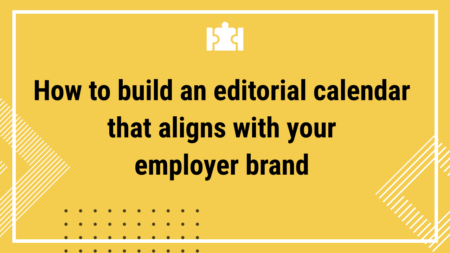A well-defined EVP is the backbone of any company’s employer brand strategy. It paves the way for creating compelling, original, and attention-grabbing recruitment marketing content. Whether you choose to externalize your approach and work with an agency specialized in employer branding or you choose to do it yourself, uncovering your EVP will get you one step closer to attracting and retaining the best people for your business.
There are many stages and stakeholders involved in the process, meaning that you must prioritize carefully to get things right. Without an EVP, the content you post online won’t resonate with your candidate persona. As a consequence, you won’t be able to develop an effective employer brand. In simple terms, an EVP is a combination of valuable factors that you are offering to the people working in your company. Elements like brand reputation, growth opportunities, outstanding perks, and an inclusive company culture lie at the heart of your EVP.
Do you – as an organization, company, enterprise, SME – have what it takes to stand out from the crowd? What factors make you become an employer of choice? Follow the steps below and learn more about designing and activating your employee value proposition.
1. The discovery phase

Why should you want to have an EVP? Prior to getting started, you must acknowledge the reasons behind needing an EVP. This will help streamline internal communication, as well as get the rest of your team on-board with the process. Furthermore, the discovery phase will enable you to craft a unique proposition that meets your company’s hiring objectives. In general, these might be:
- To reduce the costs involved in the recruitment process
- To hire more highly qualified people
- To improve productivity & staff turnover
An EVP defines the way CEOs run their business. That being said, it’s no point in bragging about offering a flexible work schedule unless you truly offer a flexible work schedule. When your business operates in line with your EVP, your employees will value the workplace more. They’ll be happier, more motivated, more productive, and will stay longer.
Attracting the best people becomes easier when you stay true to your company’s values and you are honest about your company’s challenges. Because a job where you do what you want, when you want, and if you want doesn’t exist. That’s a hobby.
Last but not least, the objective of your EVP is to help you define the unique value proposition of your company. Doing something similar to your competitors is the last thing you want. And yet, that doesn’t mean you can’t get inspired. There’s nothing wrong with research competitors to gather valuable insights and learn more about their EVP and employer brand strategies.
US-based payment company Stripe, for example, encourages people to apply to their job ads even if their resumes don’t match all of their requirements. At the end of every job post, you’ll see this message:
“At Stripe, we’re looking for people with passion, grit, and integrity. You’re encouraged to apply even if your experience doesn’t precisely match the job description. Your skills and passion will stand out—and set you apart—especially if your career has taken some extraordinary twists and turns. At Stripe, we welcome diverse perspectives and people who think rigorously and aren’t afraid to challenge assumptions. Join us.”
2. The analysis phase

Phase two of defining your EVP will attempt to answer two questions: why people like working for your company and why they leave. Your EVP has to be authentic and honest. If you end up promising one thing and your employees experience something totally different, they’ll feel betrayed. A meaningful, accurate EVP is best outlined following an in-depth analysis of employee data.
The best strategy for gathering EVP data is via surveys and interviews. Open-end questions are great at collecting details on what it feels like to work at your company. For inspiration, we recommend some sample survey questions from TalentLyft. Capture all responses and use the results to plan your next move and get one step closer to defining your employee value proposition.
Some tips and tricks on collecting employee data:
- Create anonymous, simple surveys that can be easily exported. We recommend Google Forms and SurveyMonkey.
- If you decide to hold interviews, appoint someone to take notes or record the interviews
- Set up a Q&A session about what it feels like to work at your company on teambuildings or team camping trips
- Organize monthly lunch meetings someplace nice and fancy, and appoint team leaders to discuss challenges in a friendly environment where they can speak freely
There are numerous other mechanisms you can use to collect employee data. You can always get creative and do whatever you think resonates with your people. Don’t shy away from holding exit interviews with people that want to leave your company. Use it as an opportunity to ask the big question: WHY?
Gather all the information (good and bad) and use it to frame your EVP. By now, you should be able to understand the essential things people love about working for you, as well as what makes your company appealing, interesting, and different from the rest. And because no company is perfect, you’ll also get an idea of your “flaws” and what made them leave – this is an opportunity to make improvements within the company culture.
3. The framing phase

A fundamental part of your EVP is the framing of your company’s unique offers. Both the discovery analysis and the analysis phase will now help you design the things that set you apart. Strong EVPs are crafted to be enticing to the candidate persona your company is looking to attract. Sometimes, understanding what future employees want comes down to great health insurance, flexible work schedule, and career development. However, there are people that want more than that. Some might want the unexpected like an office with a view, a nap room, a gym, etc. The problem is, there are companies that go by the following mentality: “I’m too traditional and all of my competitors are offering similar benefits. How can I design an EVP that’s unique?”
You’d be surprised! That’s why the discovery phase matters just as much as the analysis phase. Not every single perk of your unique value proposition has to be out of this world. Your focus should be on framing a unique combination of benefits. In general, your EVP should center on the following:
- Salary: explore industry benchmarks to see how your company can compare. Do you have leverage or not?
- Other financial benefits: do you have a system for analyzing salary increases, quarterly bonuses, and promotions? How transparent is your system?
- Non-financial benefits: appreciated benefits are flexible work hours (that enable employees to meet goals rather than meet a certain number of hours at an office desk), but also career development opportunities. For example, Adobe offers its employees $10,000/year for books and courses.
- Stability: knowing that an employer can offer stability gives people peace of mind and assurance that in times of crisis they won’t lose their job. If you’re an established company and can guarantee stability, you should definitely include it in your EVP.
- Autonomy: your people should be allowed to fix problems at their own pace. Have a conversation with them to set objectives and deadlines, as this will feel that you’ve got their back; and that you’re offering them the freedom to do their job without having someone breathing down their necks every couple of hours.
- Work-life balance: also known as the mother of all benefits in a company. It does matter to give your employees freedom. Forcing them to stick to the 9 to 5 schedule won’t bring them much joy. No matter the salary, at some point they’ll snap.
- Colleagues: how friendly and open-minded are your current employees? Hiring new people is hard enough, so you have to make sure they don’t resign because of a mismatch.
- Managers & team leaders: what kind of managers and team leaders do you have at your company? Can they mentor the newcomers? Do they possess emotional intelligence?
- Teamwork & collaboration: there’s no secret that teamwork is vital in any company. But then again, crafting a company culture where people are more productive together than alone is not easy. The more you reward teams the better chances you have to keep people united, happy, and productive. Key results, goals, and objectives create team alignment; not to mention that it ensures everyone that they’re on the same page.
- Trust: do you pride yourself with a great company reputation? Don’t hesitate to use it in your EVP.
Needless to say, the list can go on. Framing an EVP successfully is not about using all of the above elements and shouting out loud that working at your company is a phenomenal opportunity that no other company can offer. No, it’s not about that. The secret is to assess what your company can truly offer. It’s about being honest and transparent about your own perks and challenges.
4. The EVP draft phase

It’s time to get down to business and create your EVP components. Please note that your statement(s) must:
- Be in alignment with your company’s mission, vision, and values.
- Be honest, transparent, and achievable. It should paint a genuine picture of what your company is truly like and not beat around the bush with stuff your company aspires to be.
- Be ready to attract & retain the candidate persona(s) you design your EVP for.
- Be open to write your EVP in your own company “language” or tone of voice.
- Be straightforward & concise.
Following the first EVP draft, the next step is to gather feedback from everyone that contributed to the framing process. Some will agree, others will disagree. In the end, your job will be to assess all feedback, address concerns, and determine the core factors lying at the heart of your culture. Once all the pieces have been put together and you’ve gotten support from suitable stakeholders (e.g HR, marketing, PR), the last step is to communicate your EVP.
5. The implementation phase

It’s time to communicate your employee value proposition to your candidate persona. But before you do that, we highly recommend that you reveal the launch to your own team first. This will get them on board from the very beginning and will create a sense of satisfaction and ownership upon seeing the outcome of your efforts.
Make sure to update all internal documents to match your new EVP, including:
- Careers page
- Employee handbook
- Job descriptions
- Social media accounts
- Marketing campaigns
For your EVP to be communicated properly, you have to look at both direct and indirect channels. If you’re sending emails to job seekers, don’t forget to update the message to reflect your new EVP. The same thing goes for social media advertising and all content you plan to post/promote on your website from this point forward.
Final thoughts
Your EVP will change through time. It’s not static and it should be constantly monitored and updated to match your culture. Every 6 months, we highly recommend that you revisit your EVP to make sure it still resonates with your people.
A transparent, well-defined EVP is the backbone of your employer brand.
The more strategic you are with implementation throughout your candidate persona’s journey the better chances you have to communicate clearly how it feels to work at your company.
US-based consulting company Bain & Company is listed as Glassdoor’s No. 1 Best Places to Work. In just a few lines, their EVP sounds something like this: “Picture yourself at one of the world’s best places to work, surrounded by teams and people who challenge you, support you, and inspire you to be extraordinary.” To attract top talent Bain & Company has brought on other opportunities, such as collaboration with different teams across different offices and departments around the world.
Their strategy to make their EVP memorable has been to highlight common perks like flextime, global transfers, externship opportunities, and parental leave, with one unique perk deemed “take two”, which is an opportunity for employees to take two months off of work to accomplish personal goals or just chill on a sunny beach and meditate. That’s the secret to a well-defined EVP: classic benefits mixed with something unique that only your company can offer.






